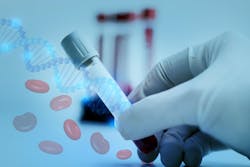A new twist: How the COVID-19 pandemic paved the way for increased molecular testing of hepatitis
SARS-CoV-2 and hepatitis might not seem to have much in common, but in the world of clinical laboratory testing, they have become intertwined.
After the unprecedented infrastructure scale-up that occurred in clinical labs during the COVID-19 pandemic, demand for SARS-CoV-2 testing has now fallen to a fraction of its peak volumes. Laboratory teams around the world have extra capacity thanks to the higher-throughput platforms or additional instruments they implemented to handle pandemic testing.
With all of that investment, labs are now in the unusual position of figuring out how to best utilize it in a post-pandemic era. While the typical approach is to adopt new testing platforms reactively when demand for a certain assay or capability is obvious, many lab teams now have surplus instrument capacity — and the unfamiliar luxury of being able to use this capacity to proactively select the most impactful new tests for their patient population.
Fortunately, many of the molecular diagnostic platforms that were implemented by labs for the pandemic surge can run a broad menu of tests, giving labs real flexibility and choice in how they use these instruments going forward. Diagnostic reagent manufacturers are continuously innovating to develop products that best serve laboratories and deliver on the promise of this increased capability.
This is where hepatitis comes into play. Back in 2016, the World Health Organization (WHO) announced its intention to prioritize public health efforts to reduce the incidence and impact of viral hepatitis. The goal is to slash the number of cases by 90 percent and the number of deaths by 65 percent by the year 2030 (with all numbers based on 2015 global statistics for hepatitis).1 The WHO’s top targets are hepatitis B and C, the viral strains associated with a high risk of mortality due to their ability to cause cirrhosis and liver cancer.
If these goals can be met in that ambitious timeline, the WHO predicts that it would prevent approximately 4.5 million deaths.2 The hepatitis elimination program includes a number of broad recommendations that public health leaders in each country can choose from based on their own population’s status. For example, the use of vaccinations, therapies, and diagnostic tools is recommended in a variety of ways, as are means of monitoring progress over the years. The initiative also aims to rein in vertical transmission of hepatitis, which is a particularly dangerous mode of infection. When mothers infect their babies in utero or during birth, there is very high risk for those children to suffer chronic, possibly lifelong infections.
Laboratories may not have had the opportunity to prioritize hepatitis B and C testing before the pandemic, but now these targets have become popular choices for how to make use of the extra testing capacity that is currently available. Molecular diagnostic tests typically cover both hepatitis B and C, and some broader panel tests include rare strains, which makes it easy to add hepatitis testing to a lab’s menu using the same platforms that were brought in for COVID-19 testing. When performed with high-quality synthetic controls for safety, this approach delivers accurate results that will help labs contribute to the global goal of eliminating hepatitis.
How to test for hepatitis
The Centers for Disease Control and Prevention (CDC) has developed a useful set of recommendations to help guide providers and clinical lab professionals in knowing when to use hepatitis screening or testing for their patients. Here’s a brief summary.
In general, all adults aged 18 or older should be screened at least once for each type of hepatitis. For hepatitis B, the CDC advises using a triple panel serology test that detects the surface antigen and antibody, as well as the IgM antibody and total antibody to the hepatitis B core antigen.3 This represents more comprehensive coverage than the agency’s older testing guidelines, which focused on detection of the surface antigen only. For hepatitis C, the CDC calls for near-universal screening but allows for exceptions in areas where the prevalence of this virus is vanishingly low, at 0.1 percent or less.4
Pregnant women should get increased attention to prevent transmission from mother to child. The CDC recommends screening all pregnant women for hepatitis B using a surface antigen test, ideally during the first trimester. For women who are positive for the virus, their newborns should also be tested with an assay designed to detect the surface antigen or antibodies to it. For hepatitis C, the recommendation is similar: screening should be performed in every pregnancy unless the woman lives in a region where hepatitis C is quite rare.
For patients at higher risk, the CDC advises more frequent testing. Hepatitis B tests should be performed periodically for patients who have previously tested positive for sexually transmitted infections, people who were born in areas with a high incidence of the virus, people who were or are incarcerated, men who have sex with men, patients on dialysis, and people who have a history of using drugs by injection, along with a few other high-risk groups. Routine hepatitis C testing is recommended for dialysis patients as well as for people who inject themselves with drugs or share needles with other drug users. In addition, one-time hepatitis testing is advised for anyone with HIV, people who have received blood transfusions or organ transplants, medical professionals who are exposed to hepatitis C, or children of women found to have the virus.
Why synthetic controls matter
While there is a good selection of molecular diagnostic tests for hepatitis B and hepatitis C to be considered by clinical lab professionals, one component is often overlooked in the evaluation phase. Assays perform best when paired with safe, high-quality controls. Some diagnostic manufacturers include appropriate controls in the test kit, but in many cases, lab teams are left to their own devices for acquiring the right controls.
Unfortunately, many labs turn to controls that may seem easier to acquire but confer high risks. Remnant patient samples or attenuated viral strains are used all too often but are known for being unsafe. Both options put lab staff at risk of infection as the hepatitis virus is noted for its extreme transmissibility and durability. In addition, patient samples make a suboptimal control because of their unpredictable supply. To ensure their ability to meet demand for hepatitis tests, clinical labs need a control type that is readily available.
Synthetic molecular controls offer a safer, cost-effective approach that allows for high-quality results without risking the health of lab members. Designed to mirror the viral genome of hepatitis B or C, they can be customized quickly for various targets. Synthetic controls are produced in carefully controlled laboratories with rigorous manufacturing practices. Because they are not infectious, they are easier to ship and store compared to other types of controls.
One type of synthetic control comes with the added advantage of a viral-like coating making it ideal for monitoring the entire testing workflow. These controls are encased in a protein layer that serves as a kind of armor, stabilizing the control and protecting its nucleic acids. Adding the layer of armor reduces the risk of RNA or DNA degradation in most biological matrices, so the controls can be used from the time the sample is extracted, riding along through most DNA or RNA isolation techniques. When used as an exogenous control throughout the sample’s entire journey, these armored controls allow laboratorians to evaluate the performance of each step of the diagnostic workflow to ensure reliable results. Armored controls for hepatitis C are compatible with a variety of clinical assay types and can also be useful for developing new molecular tests for this family of viruses.5
In conclusion
The elimination of hepatitis is an ambitious and worthy public health goal. Clinical laboratories will be essential to this work by performing robust and reliable diagnostic testing for hepatitis B and C. Now that many labs have extra capacity available on their molecular testing platforms as COVID-19 testing demand eases, deploying some of that infrastructure to join in the global fight to end hepatitis will be an important step to improve care for many patient populations.
References
1. WHO releases first-ever global guidance for country validation of viral hepatitis B and C elimination. Who.int. Accessed December 14, 2023. https://www.who.int/news/item/25-06-2021-who-releases-first-ever-global-guidance-for-country-validation-of-viral-hepatitis-b-and-c-elimination.
2. Hepatitis. Who.int. Accessed December 14, 2023. https://www.who.int/health-topics/hepatitis/elimination-of-hepatitis-by-2030.
3. Screening and testing recommendations for chronic hepatitis B virus infection (HBV). Cdc.gov. Published May 3, 2023. Accessed December 14, 2023. https://www.cdc.gov/hepatitis/hbv/testingchronic.htm.
4. Testing recommendations for hepatitis C virus infection. Cdc.gov. Published October 30, 2023. Accessed December 14, 2023. https://www.cdc.gov/hepatitis/hcv/guidelinesc.htm.
5. WalkerPeach CR, Winkler M, DuBois DB, Pasloske BL. Ribonuclease-resistant RNA controls (Armored RNA) for reverse transcription-PCR, branched DNA, and genotyping assays for hepatitis C virus. Clin Chem. 1999;45(12):2079-85.





